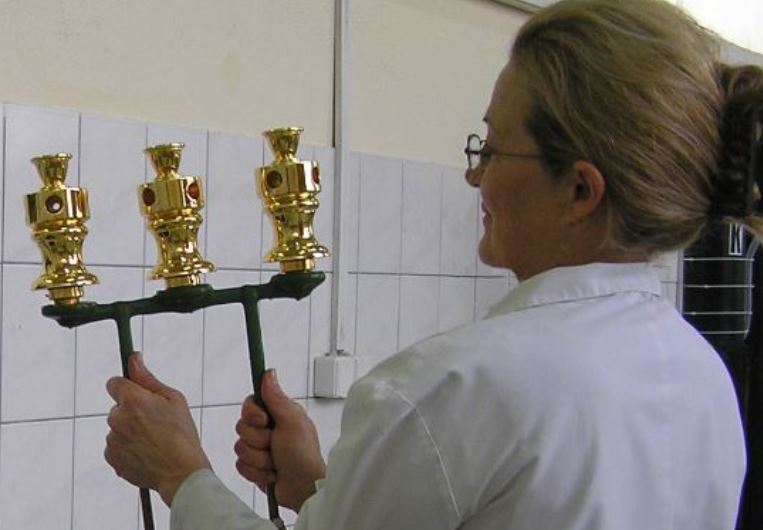Metal surfaces visible to the player’s eye include:
- turret
- (optional) cone,
- as a rule, visible parts of the separator, i.e., barriers and visible surfaces of the rotating disc,
- (optional) visible parts of the plate ¹,
- as a rule, ball deflectors.
Below, we will list more or less common varieties and compare their advantages and drawbacks.
This variety is often seen on the surfaces of rotating disk and separator and is characterized by its cost-efficacy and aesthetic instability. Aluminium, and particularly its alloys used in casting as is the case here, as such is not resistant to oxidation and tarnishes in time. The reason why this method is used by some manufacturers is that aluminium alloys are not suitable for use of some metallic appearance surface coatings although such surfaces look quite nice initially. An interesting thing is that it is the method of choice for the most renowned manufacturers of traditional roulette wheels as well as many automated roulette manufacturers.
2) Electroplated brass
This variety is most frequently seen on turrets, ball deflectors ², barriers, or separators, and only sometimes on the visible surfaces of rotating disc and plate ¹ as well as cone. Electroplating is divided into two most frequently used types of surface coating, being nickel plating and gilding. Both these types of surface coating are resistant to oxidation, well resistant to chemicals, but the area where they differ significantly is their mechanical resistance. While nickel provides very hard surface of excellent resistance to tear and wear and aesthetic stability, gilding provides somewhat softer surface more prone to tear and wear, although the level of resistance to some extent depends on the composition of the gold alloy ². Nickel plating is also somewhat cheaper than gilding but notwithstanding that, due to its appeal, gold is still customers’ first choice. In case of visible surfaces of discs and plates ¹, use of this method requires production of segments from materials suitable for direct electroplating – primarily brass, which are then mechanically affixed to their aluminium bodies, which means a significant increase in the production cost notwithstanding the cost of the surface coating itself. That is also the reason why it is used by only a few manufacturers.
3) Anodized aluminium
Anodization provides surfaces resistant to oxidation, chemicals, but also relatively resistant to mechanical impacts. With the exception of white colour, there is a wide choice of available shades. The anodization itself is not very expensive but, just like electroplating, it is not suitable for use on casts used for large segments of roulette wheels. A special feature of this variety is a surface of silky glare, of moderate reflection, favouring live streaming, particularly in case of large surfaces such as cone and separator.
Notes
¹ Visible portion of the plate is the ring-formed static surface between the rotating disc with the separator and the wooden bowl.
² CTI exclusively applies the method of so called “hard gilding”.
| Visible metal surface variety | Stability | Cost | Interesting fact | ||
| Unprotected surface aluminium | ⋆⋆ | Very cost-effective. | Used by most famous manufacturers of manual roulette wheels and by many producers of automated roulettes. | ||
| Electroplating | Gold | ⋆⋆⋆ | Significantly higher cost if used on all surfaces; medium cost in case of selective use. | More expensive than nickel. | Highest demand, less common use on all surfaces. |
| Nickel | ⋆⋆⋆⋆⋆ | Less expensive than gold. | Lower demand, less common use on all surfaces. | ||
| Anodized aluminium | ⋆⋆⋆⋆ | Significantly higher cost if used on all surfaces; medium cost in case of selective use. | Compatible with modern design, lower reflection – suitable for live streaming | ||





